Everest Base Camp Trek 2024: The Ultimate Guide to a Sustainable and Cultural Himalayan Adventure
Everest Base Camp Trek 2024: The Unforgettable Journey
Everest Base Camp Trek 2024 offers an unparalleled journey into the heart of the Himalayas. This comprehensive guide invites you on a trek that is as challenging as it is rewarding, weaving through breathtaking landscapes and rich Sherpa culture. Discover essential tips for acclimatization, a detailed itinerary, and insights into sustainable trekking practices. Whether you’re a seasoned trekker or a first-time adventurer, this trek promises a once-in-a-lifetime experience, balancing physical endurance with profound cultural immersion. Get ready to embark on an adventure that will not only test your limits but also expand your horizons in the majestic Everest region.

Imagine standing amidst the towering peaks of the Himalayas, breathing in the crisp mountain air, surrounded by the grandeur of nature at its most majestic. This is the allure of the Everest Base Camp Trek 2024, a journey to a destination and a dream. Regarded universally as a bucket list adventure, the Everest Base Camp Trek represents more than just a trek; it’s a pilgrimage to the heart of the Himalayas, a once-in-a-lifetime experience that beckons adventurers from all corners of the globe.
Set in the stunning landscape of Nepal, trekking to Everest Base Camp is a physical endeavour and a cultural immersion. The trek weaves through the Khumbu region, home to the legendary Sherpa community, whose warmth, hospitality, and rich traditions add profound depth to this journey. As you traverse this revered path, you’re not just walking on trails; you’re treading through history, culture, and many stories that the Himalayan peaks have silently witnessed.
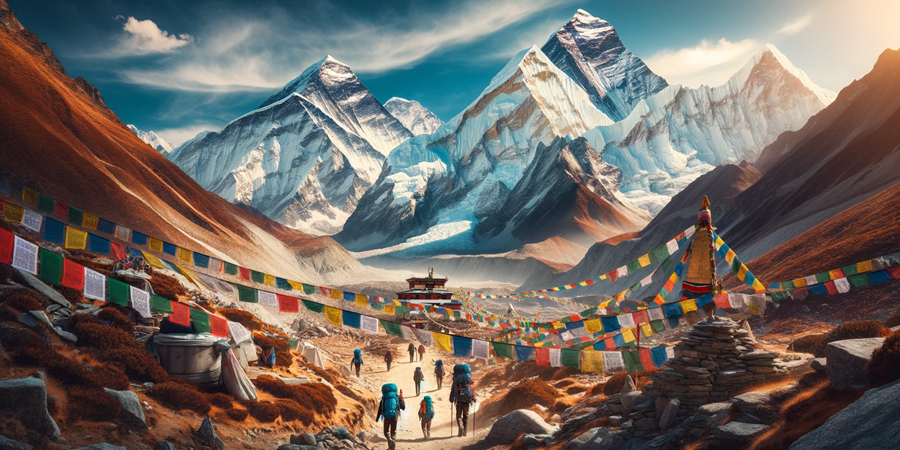
In 2024, the Everest Base Camp Trek promises even more for trekkers. Whether it’s the enhanced trails, the evolving local practices that offer a more sustainable and ethical trekking experience, or the increased awareness of preserving the natural beauty of these towering mountains, the trek is more than just a physical journey. It’s a testament to the harmonious coexistence of humans and nature, a balance the local communities have mastered and continue to uphold.
But what truly sets the Everest Base Camp Trek 2024 apart is the indomitable spirit of the Himalayas themselves. These mountains are physical structures and symbols of resilience, beauty, and the eternal quest for adventure. Trekking in Nepal, especially to the Everest Base Camp, is as much about discovering these majestic mountains as it is about finding oneself. It’s a journey that challenges you, changes you, and ultimately leaves you with a sense of accomplishment that few other experiences can match.

And yet, the Everest Base Camp Trek is more than just a physical challenge; it’s a spiritual and emotional journey. As you ascend through diverse terrains, from lush forests to barren landscapes, every step takes you closer to understanding the sheer might of the Himalayas and the humility it instils. The trek is an unfolding story, with each day bringing challenges, wonders, and learning.
As you prepare for the Everest Base Camp Trek 2024, you’re not just preparing for a trek; you’re gearing up for an adventure that will redefine your understanding of beauty, endurance, and the human spirit. It’s a journey that will take you through some of the most breathtaking landscapes on Earth, introduce you to a culture steeped in richness and warmth, and challenge you to push your limits.
Whether you’re a seasoned trekker or a first-time adventurer, the Everest Base Camp Trek 2024 is an experience that should not be missed. It’s an opportunity to witness the grandeur of the Himalayas, immerse yourself in the culture of the Sherpa people, and embark on a journey that is as much about exploring the external landscapes as it is about exploring the internal landscapes of your soul.

The Everest Base Camp Trek 2024 is not just a trek; it’s a journey of a lifetime. It’s an adventure that beckons you to embrace the unknown, step out of your comfort zone, and experience the sheer joy of being amidst the highest peaks in the world. So, pack your bags, lace up your boots, and prepare for an adventure that will leave you with memories to cherish for a lifetime.
Everest Base Camp Trek 2024 Itinerary – A Journey Through the Heart of the Himalayas
Embarking on the Everest Base Camp Trek in 2024 is not just a trek; it’s an odyssey through some of the most spectacular landscapes on Earth. This meticulously planned itinerary ensures that each day unfolds a new layer of the Himalayas’ majesty, introducing trekkers to Nepal’s cultural richness and breathtaking beauty. Let’s embark on this day-by-day journey, where every stop is a story, and every view is a memory etched in time.
Day 1-2: Kathmandu to Lukla, Trek to Phakding. Your journey begins in Kathmandu, where the vibrant culture of Nepal greets you. A scenic flight to Lukla offers your first glimpse of the Himalayas, a prelude to the adventures ahead. The trek to Phakding is a gentle introduction to the Khumbu region, where the melody of the Dudh Kosi River accompanies you.
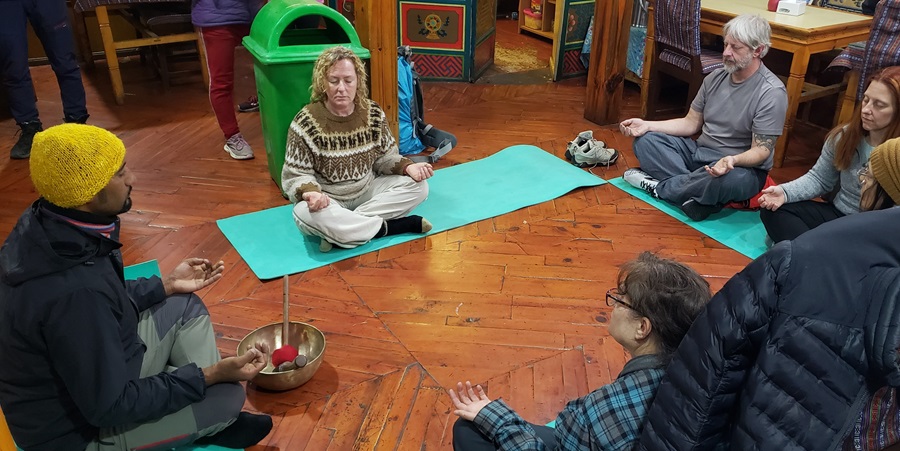
Day 3: Phakding to Namche Bazaar Trekking to Namche Bazaar, the gateway to Everest, you’ll encounter suspension bridges adorned with prayer flags, whispering the prayers of trekkers past and present. Namche Bazaar, a bustling Sherpa town, is a tapestry of culture and commerce nestled in the heart of the mountains.
Day 4: Acclimatization in Namche Bazaar A crucial day for acclimatization, Namche offers splendid panoramic views and the opportunity to explore local museums and monasteries. It’s a day to soak in the Sherpa culture and prepare for higher altitudes.
Day 5: Namche to Tengboche The trek to Tengboche is a journey through rhododendron forests, with the majestic Ama Dablam overseeing your path. Tengboche Monastery, a spiritual haven, welcomes you with its serene ambience and stunning backdrop of Everest and its companions.

Day 6: Tengboche to Dingboche As you head towards Dingboche, the landscape transforms, revealing the stark beauty of the higher Himalayas. Dingboche, known as the ‘summer valley’, offers a peaceful respite and another day for acclimatization, preparing you for the higher reaches of the trek.
Day 7-8: Dingboche to Lobuche The journey to Lobuche is marked by memorials for climbers who’ve braved Everest, a sad reminder of the mountain’s might. The Khumbu Glacier’s moraine presents a dramatic landscape, leading you to Lobuche, a hamlet offering views that are simply ethereal.
Day 9: Lobuche to Gorak Shep, Visit Everest Base Camp. Reaching Gorak Shep, you’re on the edge of your dream – Everest Base Camp. The trek to Base Camp is a surreal experience, where every step brings you closer to the pinnacle of the Earth. Standing at Everest Base Camp, you’re not just at a physical location; you’re at the zenith of a dream, the culmination of every step taken.

Day 10: Gorak Shep to Kala Patthar, Descend to Pheriche An early morning trek to Kala Patthar offers a sunrise that redefines beauty, illuminating the Everest panorama. The descent to Pheriche is a journey back through time as you retrace your steps, carrying a heart full of memories.
Day 11-13: Pheriche to Namche Bazaar and Lukla. The return trek to Namche and Lukla is a time for reflection as the Himalayas bid you a gradual farewell. It’s a journey of contemplation, cherishing the experiences and the lessons learned.
Day 14: Lukla to Kathmandu As you fly back to Kathmandu, you carry with you not just photographs, but a canvas of experiences, painted with the colors of the Himalayas, the culture of its people, and the spirit of Everest.
The Everest Base Camp Trek 2024 is more than an itinerary; it’s a transformative journey that intertwines the Himalayas’ grandeur with its people’s warmth. Each stop is an opportunity to witness the awe-inspiring beauty of nature and the resilience of the human spirit, making this trek an experience that transcends physical boundaries and touches the soul.
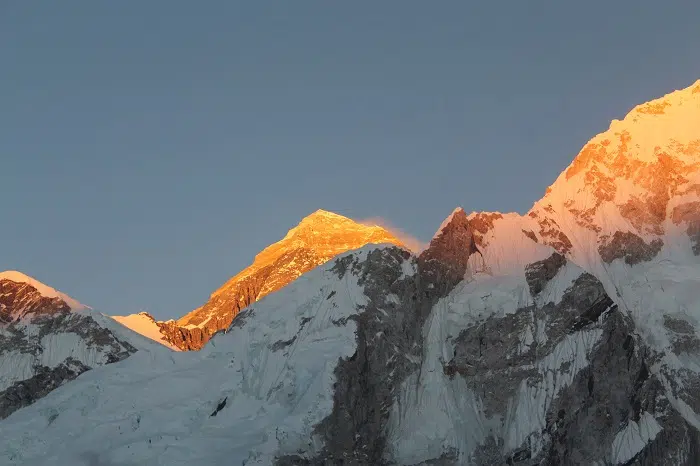
Acclimatization and Safety on the Everest Base Camp Trek 2024: Ensuring a Healthy and Rewarding Journey
Acclimatizing properly and ensuring safety are crucial elements of the Everest Base Camp Trek 2024. As trekkers ascend the majestic heights of the Himalayas, understanding and respecting the body’s need to adapt to the altitude is paramount. This section focuses on the importance of acclimatization to prevent altitude sickness and offers practical tips for staying safe and healthy throughout this remarkable journey.
The Importance of Acclimatization Acclimatization is not just a recommendation; it’s a necessity for the Everest Base Camp Trek. Altitude sickness, also known as Acute Mountain Sickness (AMS), can affect anyone, regardless of fitness level or experience. As you ascend above 2,500 meters, the air becomes thinner, and oxygen levels decrease. The body needs time to adapt, making acclimatization days essential.
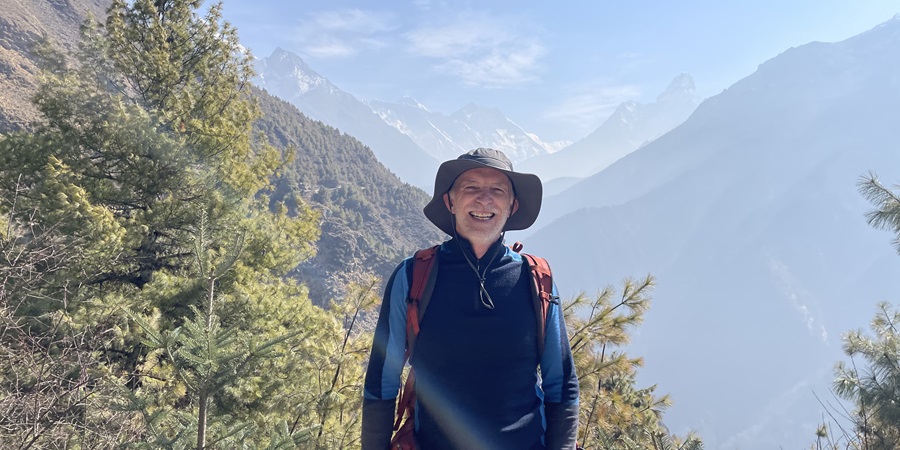
On the trek to Everest Base Camp in 2024, designated acclimatization days are included in Namche Bazaar and Dingboche. These stops are not mere rest days; they are critical for your body to adjust to the higher elevations. Engaging in light activities during these days, such as short hikes to higher altitudes followed by descent, helps your body adapt more effectively.
Recognizing and Responding to Altitude Sickness Awareness of the symptoms of AMS is crucial. These can include headache, nausea, dizziness, fatigue, and loss of appetite. If you experience these symptoms, you must immediately communicate with your guide. The key to dealing with AMS is early recognition and response. Rest, hydration, and, if necessary, descent to a lower altitude can be lifesaving measures.

Staying Safe: Practical Tips
- Stay Hydrated: The dry mountain air can lead to dehydration, exacerbating altitude sickness symptoms. Drink plenty of water and avoid alcohol and caffeine.
- Eat Well: Maintaining a balanced diet is essential. High-carbohydrate meals are recommended, as they are easier to digest at high altitudes and provide critical energy.
- Listen to Your Body: Don’t push yourself too hard. Trekking in the Himalayas is not a race. Pace yourself and rest when needed.
- Travel with a Reputable Guide: Experienced guides provide valuable insights into the local culture and landscape and are trained to recognize and respond to health issues, ensuring your safety.
- Prepare Beforehand: Physical preparation, including cardiovascular exercises, can significantly aid your body in coping with the demands of high-altitude trekking.
- Pack Essential Medications: Carry basic medications for headaches, stomach upsets, and colds. Consult with a doctor about altitude sickness medication like Acetazolamide (Diamox) if recommended.
- Invest in Good Gear: Quality trekking gear, including sturdy boots, warm clothing, and a reliable sleeping bag, can make a significant difference in your comfort and safety.
- Respect the Weather: The Himalayan weather can be unpredictable. Be prepared for sudden changes and listen to your guide’s advice regarding weather conditions.
- Know Emergency Procedures: Familiarize yourself with the emergency protocols provided by your trekking company, including evacuation procedures.
By focusing on acclimatization and adhering to these safety tips, trekkers can significantly enhance their experience on the Everest Base Camp Trek 2024. Remember, safety is not just about personal well-being; it’s about ensuring the journey is enjoyable and memorable for everyone involved. With careful planning, respect for the altitude, and adherence to safety protocols, the trek to Everest Base Camp can be a truly rewarding and life-affirming adventure.
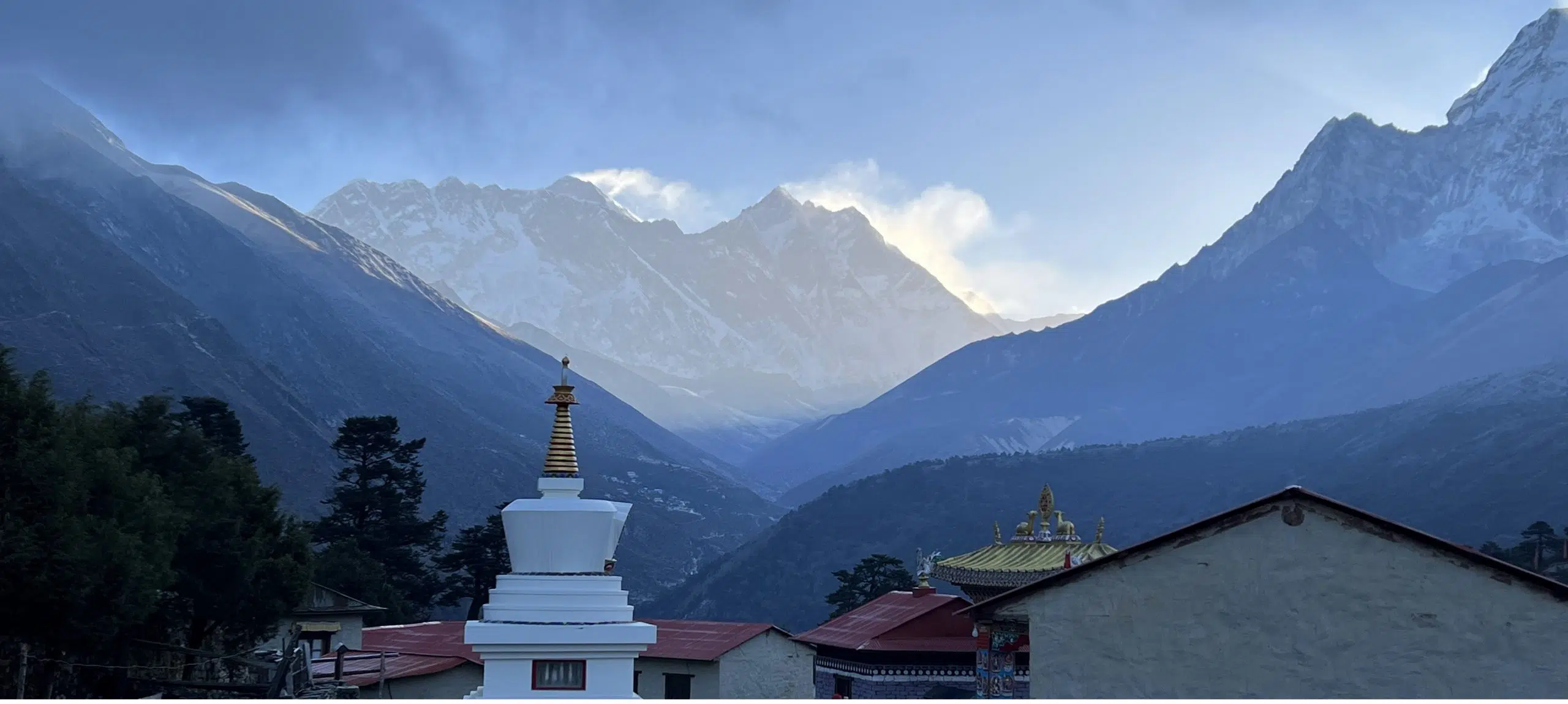
Essential Packing List for the Everest Base Camp Trek 2024: Gear Up for the Himalayan Adventure
Preparing for the Everest Base Camp Trek 2024 involves meticulous packing to ensure you have all the necessary gear and clothing for a safe and comfortable journey. This comprehensive packing list covers the essentials and provides cultural insights, embracing the local Nepali attire and customs and enhancing your experience in the Himalayas.
Clothing and Gear
- Base Layers: Moisture-wicking thermal tops and bottoms are essential for layering. They keep you warm and dry as you trek.
- Insulating Layers: Fleece or down jackets provide necessary warmth, especially during chilly evenings and high-altitude treks.
- Outer Layer: A waterproof and windproof jacket and trousers are crucial to protect against unpredictable Himalayan weather.
- Trekking Boots: Invest in good waterproof, ankle-supporting boots for rough terrains.
- Trekking Socks: Woolen or synthetic socks that wick away moisture and provide comfortable cushioning.
- Headgear: A warm hat, a sun hat, and a buff or neck gaiter to protect against sun and cold.
- Handwear: Insulated gloves for warmth and lighter gloves for milder conditions.
- Daypack: A comfortable, water-resistant daypack to carry your essentials during the trek.
Tech and Accessories
- Headlamp: Essential for early morning or late evening treks.
- Sunglasses: UV-protection sunglasses to shield your eyes from intense sun glare.
- Water Purification: Water purification tablets or a water filter to ensure safe drinking water.
- Trekking Poles: Helpful for stability and reducing strain on the knees.
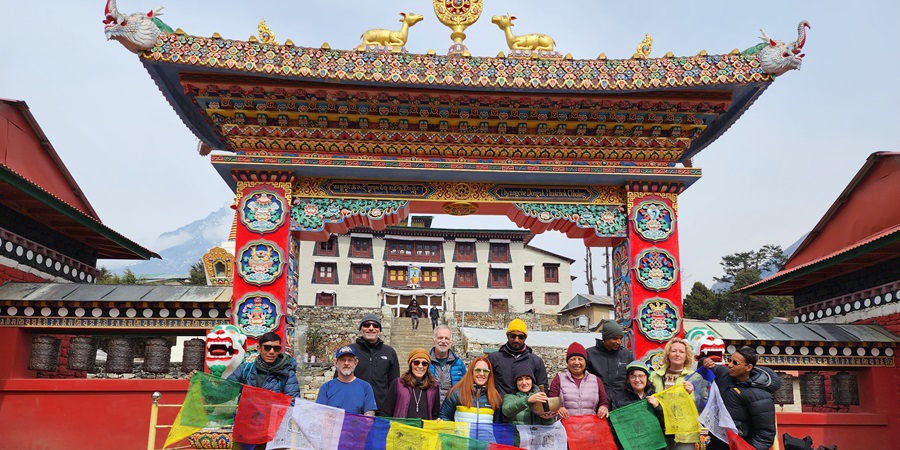
Health and Hygiene
- First-Aid Kit: Include basic medical supplies, blister care, and altitude sickness medication.
- Personal Hygiene Items: Biodegradable soap, toothpaste, toothbrush, and wet wipes.
- Sunscreen and Lip Balm: High SPF sunscreen and lip balm to protect against sunburn.
Cultural Respect and Integration
- Local Attire: Consider packing a traditional Nepali scarf or hat as a gesture of respect and cultural integration.
- Modest Clothing: For cultural sensitivity, pack clothes that cover shoulders and knees, especially when visiting monasteries or religious sites.
- Gifts for Locals: Small, thoughtful gifts like school supplies can be a kind gesture for the communities you visit.
Extras
- Camera: To capture the breathtaking vistas and cultural experiences.
- Snacks: Energy bars and trail mix to keep you fueled.
- Journal: To document your experiences and reflections on this once-in-a-lifetime trek.
Remember, while packing for the Everest Base Camp Trek 2024, balancing between being well-prepared and overpacking is crucial. Every item should be carefully considered for its necessity and utility. Additionally, respecting the local culture and customs through your attire and interactions enriches your experience and fosters a deeper connection with the people and places you encounter on this remarkable journey.

Best Time to Trek and Costs for the Everest Base Camp Trek 2024: Planning Your Himalayan Journey
When planning your Everest Base Camp Trek in 2024, two crucial aspects to consider are the best time to embark on this adventure and the costs involved. Understanding the ideal trekking seasons and budgeting are critical to a fulfilling and well-planned journey.
Best Seasons for Trekking
- Pre-Monsoon (Spring): March to May
- Weather: This period offers warm days and clear skies, ideal for stunning views of the Everest range.
- Scenery: The hills are vibrant with blooming rhododendrons and other flora.
- Consideration: Trails can be busy as this is a peak season.
- Post-Monsoon (Autumn): September to November
- Weather: Stable weather with clear skies and moderate temperatures.
- Scenery: The post-monsoon clarity offers some of the best mountain views.
- Consideration: Autumn is a popular time like spring, so expect some crowded trails.
Avoiding the monsoon season (June to August) is advisable due to heavy rains and potential flight delays. Winter (December to February) offers clear skies but can be extremely cold, especially at higher altitudes, and some guesthouses may be closed.
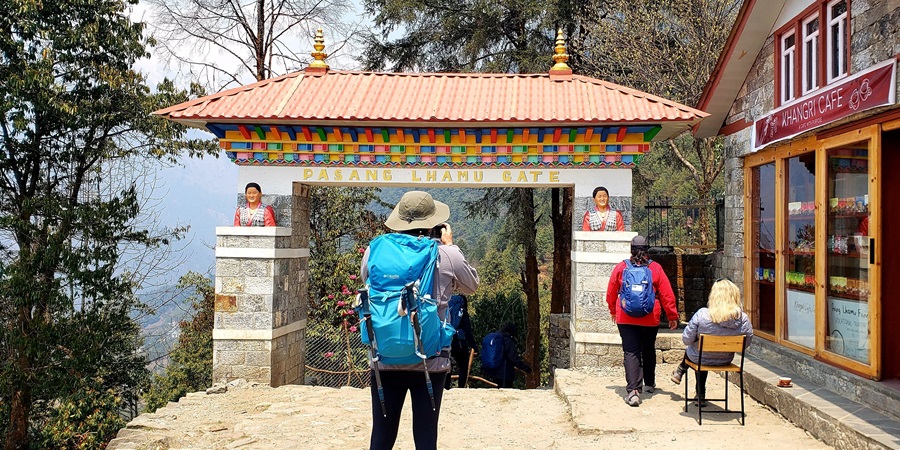
Costs Involved in the Trek Trekking to Everest Base Camp in 2024 can be tailored to various budgets, but here are some everyday expenses to consider:
- Flights: Round-trip flights from Kathmandu to Lukla are significant expenses.
- Permits: TIMS (Trekkers’ Information Management System) card and Sagarmatha National Park entry fee.
- Accommodation: Costs vary from basic teahouses to more comfortable lodges.
- Food and Drink: Meals on the trek are relatively affordable, but costs can increase, especially for items like bottled water and snacks.
- Guide and Porter Services: Hiring a guide and/or porter adds safety and convenience but also increases costs.
- Gear and Equipment: Rental or purchase of trekking gear, if not already owned.
- Travel Insurance: Essential for covering high-altitude trekking.
- Miscellaneous: Including tips for guides and porters, souvenirs, and personal expenses.
Budgeting Tips:
- Everest Base Camp Trek 2024 Group Trekking: Joining a group can reduce costs significantly.
- Book in Advance: Early booking of flights and lodges can save money.
- Local Gear Purchase: Buying or renting gear in Kathmandu can be more economical.
- Off-Peak Trekking: Consider trekking in the shoulder months for lower costs and fewer crowds.
In summary, the best time for the Everest Base Camp Trek 2024 is during the pre-monsoon or post-monsoon seasons, each offering unique advantages in terms of weather and scenery. As for costs, careful planning and consideration of the various expenses can ensure a trek that fits within your budget without compromising the experience. With the proper preparation, the Everest Base Camp Trek can be an affordable and breathtaking adventure in the Himalayas.
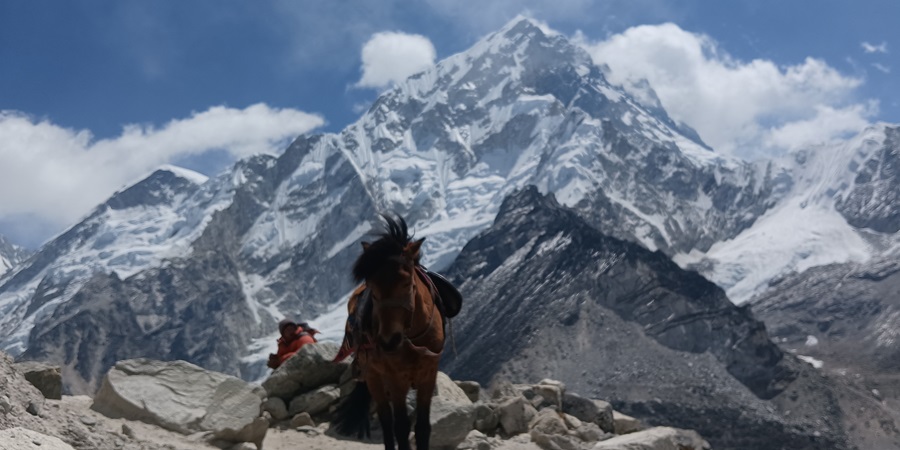
Solo and Alternative Treks for the Everest Base Camp Trek 2024: Embracing Independence and Uncharted Paths
Embarking on the Everest Base Camp Trek in 2024 presents an array of options, catering to different preferences and styles of trekking. Whether you are drawn to a solo trek or seek alternative routes less travelled, the Himalayas offer many possibilities.
Solo Trekking: A Journey of Self-Discovery Trekking solo to Everest Base Camp can be an advantageous experience, offering a sense of independence and a unique opportunity for self-reflection. However, it also demands thorough preparation and awareness.
- Preparation and Research: Understand the route, challenges, and necessary permits. Being well-informed is crucial for a successful solo trek.
- Safety and Navigation: While the trail to Everest Base Camp is well-marked, having a reliable map or GPS device is essential. Always inform someone of your itinerary and check in regularly.
- Flexibility and Resilience: Solo trekking requires adapting to changing conditions and making decisions independently.
- Building Connections: Trekking solo doesn’t mean being alone. The trail offers many opportunities to connect with fellow trekkers and locals.
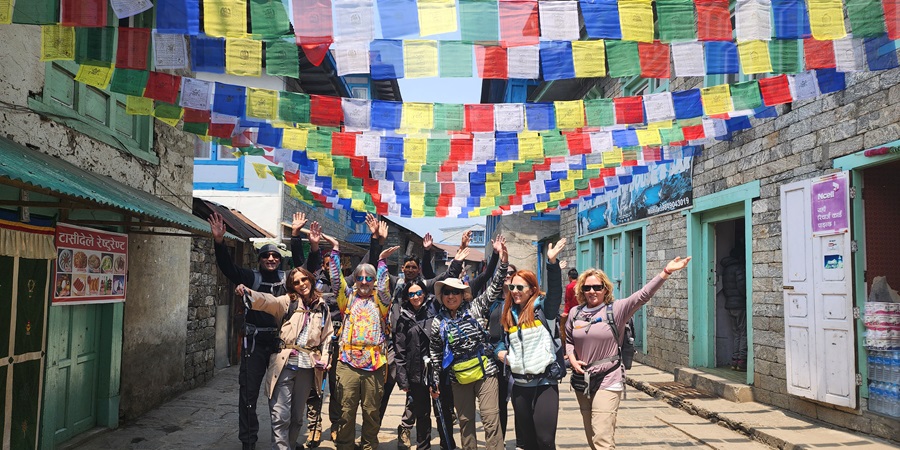
Alternative Treks: Exploring the Road Less Traveled For those seeking to explore beyond the classic Everest Base Camp trail, several alternative treks offer equally mesmerizing experiences with fewer crowds.
- Gokyo Lakes Trek: This route diverges from the classic Everest Base Camp Trek 2024 path and takes you through the stunning Gokyo Valley with its emerald lakes and panoramic views from Gokyo Ri.
- Three Passes Trek: An adventurous route for experienced trekkers, encompassing Renjo La, Cho La, and Kongma La passes, along with visits to both EBC and Gokyo Lakes.
- Arun Valley Trek: This less-travelled path offers a deeper insight into the diverse cultures of the Everest region and the chance to witness the daily lives of communities off the main tourist trails.
- Island Peak Climb: For those looking to add a mountaineering challenge to their Everest Base Camp Trek 2024, climbing Island Peak presents an exhilarating opportunity.
Combining Solo and Alternative Trekking For the ultimate adventure, connect solo trekking with one of these alternative routes. This combination allows for a deeply personal experience immersed in the less-explored vistas and cultures of the Himalayas.
Final Thoughts Whether embarking on a solo trek or exploring alternative routes, the Everest Base Camp Trek 2024 offers a spectrum of experiences for the intrepid explorer. Solo trekking, while demanding, provides an unmatched sense of accomplishment and personal growth. Alternatively, alternative treks offer the allure of discovery and the thrill of the unknown. Both paths promise an enriching journey set against the backdrop of the world’s most magnificent mountain range.

Cultural and Wildlife Insights on the Everest Base Camp Trek 2024: Discovering the Heart and Soul of the Himalayas
The Everest Base Camp Trek 2024 is a journey through stunning landscapes and a deep dive into the Everest region’s rich cultural tapestry and diverse wildlife. This section explores the vibrant culture of the Sherpa people and the unique wildlife that calls the Himalayas home.
The Sherpa Culture: A Legacy of the Mountains
- Community and Traditions: The Sherpas, renowned for their mountaineering prowess, are the soul of the Everest region. Their culture, deeply influenced by Tibetan Buddhism, is reflected in the colourful prayer flags, chortens (stupas), and monasteries that dot the landscape.
- Spiritual Beliefs: Sherpa spirituality blends Buddhism and ancient animist practices. Trekkers will encounter Mani stones and prayer wheels, each inscribed with mantras, symbolizing a culture that reveres the mountains and all living beings.
- Festivals and Celebrations: Participating in or witnessing local festivals like Mani Rimdu offers a glimpse into the vibrant community life, where music, dance, and storytelling are central.
- Cuisine: Trying local Sherpa cuisine, such as Thukpa (noodle soup) and Tsampa (barley flour), provides sustenance and a taste of local tradition.
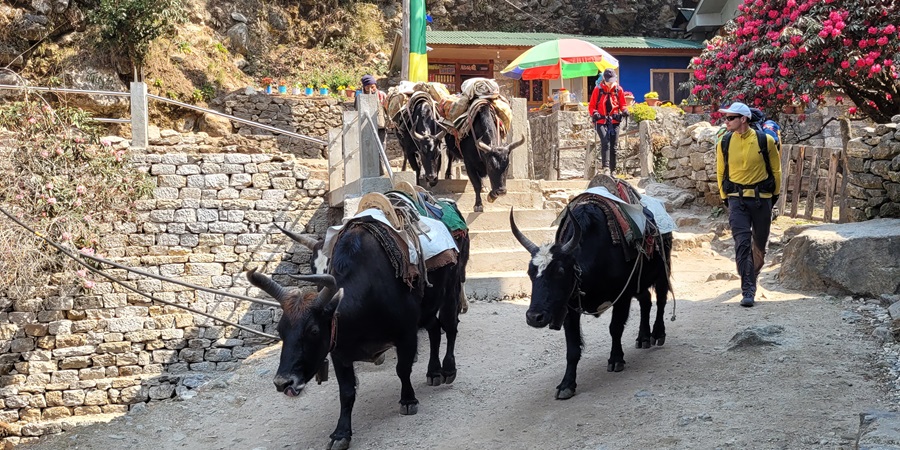
Wildlife of the Everest Region: A High-Altitude Haven The Everest region, part of the Sagarmatha National Park, is a sanctuary for various wildlife. The diversity of species found here is as astonishing as the landscape itself.
- Himalayan Tahr: A large ungulate native to the region, often spotted on steep, rocky terrains.
- Snow Leopard: Elusive and majestic, the snow leopard is a rare sight, more likely to be seen in the winter months.
- Danphe: Also known as the Impeyan Pheasant or the Himalayan Monal, this colourful bird is Nepal’s national bird and can often be seen in the forests.
- Red Panda: This adorable and endangered creature inhabits the bamboo forests and is a treat for wildlife enthusiasts.
Preserving Culture and Nature While trekking through the Everest region, trekkers must respect local customs and traditions. Participating responsibly and sustainably ensures the preservation of this unique cultural and natural heritage. Additionally, being mindful of wildlife habitats and maintaining a safe and respectful distance from animals contributes to conservation efforts.
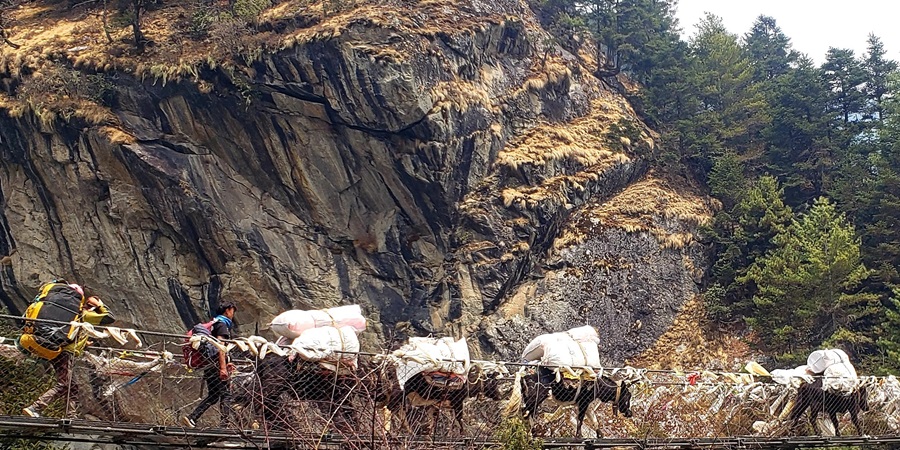
The Everest Base Camp Trek 2024 offers more than just a physical challenge; it’s a journey into the Himalayas’ cultural heart and natural soul. The Sherpa community’s rich culture and the region’s unique wildlife add depth and meaning to this once-in-a-lifetime adventure. These encounters encourage trekkers to immerse themselves, learn, and be transformed.
Photography and Memories on the Everest Base Camp Trek 2024: Capturing the Essence of the Himalayas
The Everest Base Camp Trek 2024 is not just a physical journey; it’s a visual feast brimming with breathtaking landscapes and rich cultural moments waiting to be captured. This trek is a once-in-a-lifetime opportunity for photography enthusiasts to photograph one of the world’s most awe-inspiring landscapes and the vibrant culture that thrives within it. Here are some tips to help you capture the essence of the Himalayas through your lens.
Photography Tips for the Everest Trek
- Lighting is Key: The best light is usually found early in the morning or late in the afternoon. The soft, golden light during these times can add a magical quality to your photos.
- Capture the Scale: Use people or familiar objects in your shots to give a sense of scale to the towering mountains and expansive landscapes.
- Respect Local Culture: Always ask for permission before photographing people. Capturing genuine interactions and respecting local customs will add depth to your cultural photos.
- Play with Perspectives: Experiment with different angles and perspectives to bring a unique viewpoint to your images. Sometimes, the most compelling photographs are taken from an unexpected angle.
- Be Prepared for Changing Weather: The weather in the Himalayas can be unpredictable. Protect your camera gear from elements like dust, rain, and cold.
- Focus on Details: While the grand landscapes are mesmerizing, don’t overlook the small details – a prayer flag fluttering in the wind, intricate carvings on a monastery door, or a close-up of the unique Himalayan flora.
- Battery and Memory Card Management: Cold weather can drain batteries quickly. Carry spare batteries and keep them warm in your pockets. Also, bring enough memory cards to store all your photos.
- Embrace the Elements: Don’t be deterred by bad weather. Clouds, mist, and snow can dramatically affect your photographs.

Capturing Landscapes and Cultural Moments While the majestic peaks are undoubtedly the stars of the show, the Everest Base Camp Trek 2024 is also about the journey and the people you meet along the way. Capturing landscapes is about finding the suitable composition and light, but photographing cultural moments requires respect and timing. Be present, engage with your subjects, and let your photographs tell a story of the place and its life.
Creating Lasting Memories Photography on the Everest Base Camp Trek is about more than just taking pictures; it’s about creating lasting memories. Each image you capture should be a reminder of not just what you saw but also what you felt. The laughter of the local children, the warmth of the Sherpa hospitality, and the exhilaration of reaching a viewpoint are the moments that breathe life into your photographs.
Conclusion As you embark on the Everest Base Camp Trek 2024, let your camera be a tool to document your journey and capture the beauty of the Himalayas. Remember, the best photographs often resonate with your personal experiences and the moment’s emotions. So, keep your eyes and mind open.

Preparing for the Everest Base Camp Trek 2024: Training, Nutrition, and Essential Tips for a Successful Journey
Embarking on the Everest Base Camp Trek in 2024 requires more than just a spirit of adventure; it demands physical preparation, proper nutrition, and a well-thought-out plan. This section will guide you through the training process and dietary considerations and provide “10 Tips for Trekking to Everest Base Camp” to ensure you’re fully prepared for this incredible journey.
Training for the Everest Base Camp Trek 2024
- Cardiovascular Fitness: Start with regular cardiovascular exercises such as running, cycling, or swimming to build endurance. Aim for at least 30 minutes daily, 4-5 days a week.
- Strength Training: Focus on leg strength through squats, lunges, and step-ups. Core strength is also crucial for balance and support.
- Hiking Practice: If possible, practice hiking on varied terrain, preferably with the backpack you plan to use for the Everest Base Camp Trek 2024. This helps in adapting to similar conditions you’ll face on the trek.
- Altitude Training: If accessible, train in higher altitudes to acclimate your body. Alternatively, use a stair climber or hike hills to simulate ascents.

Nutritional Advice during Everest Base Camp Trek 2024
- Balanced Diet: Incorporate a balanced diet rich in carbohydrates, proteins, and fats to build energy reserves for the trek.
- Hydration: Stay well-hydrated during training and continue this practice on the trek. Hydration aids in altitude acclimatization.
- Altitude-Friendly Foods: While on the trek, opt for easily digestible foods. Carbohydrate-rich foods like rice, pasta, and potatoes are excellent energy sources.
10 Tips for Trekking to Everest Base Camp 2024
- Start Training Early: Begin your training regimen six months before the Everest Base Camp Trek 2024.
- Invest in Good Gear: Quality hiking boots, a comfortable backpack, and appropriate clothing are essential.
- Test Your Gear: Use your trekking gear before the trek to ensure comfort and fit.
- Learn About Altitude Sickness: Be aware of the symptoms and prevention methods.
- Pack Light: Carry only what you need. Overpacking can lead to unnecessary strain.
- Stay Hydrated and Eat Well: Keep up your fluid intake and eat nutritious meals.
- Walk at Your Own Pace: Don’t rush. Trekking is not a race.
- Acclimatize Properly: Respect the acclimatization process to avoid altitude sickness.
- Be Prepared for Weather Changes: The weather can be unpredictable, so pack accordingly.
- Enjoy the Journey: Enjoy the scenery, culture, and experience.
Preparing for the Everest Base Camp Trek 2024 involves a combination of physical fitness, proper nutrition, and careful planning. Following these training tips and dietary advice will enhance your ability to enjoy and complete this challenging yet rewarding trek. Remember, it’s not just about reaching the destination; it’s about enjoying every step of the journey.
Ethical and Sustainable Trekking on the Everest Base Camp Trek 2024: Preserving the Beauty of the Himalayas
Adopting an ethical and sustainable approach is imperative as we plan for the Everest Base Camp Trek in 2024. This ensures a more enriching experience for trekkers and helps preserve the pristine beauty of the Himalayas for future generations. Here, we’ll explore the key ethical considerations and sustainable practices that should guide your Everest Base Camp Trek 2024.
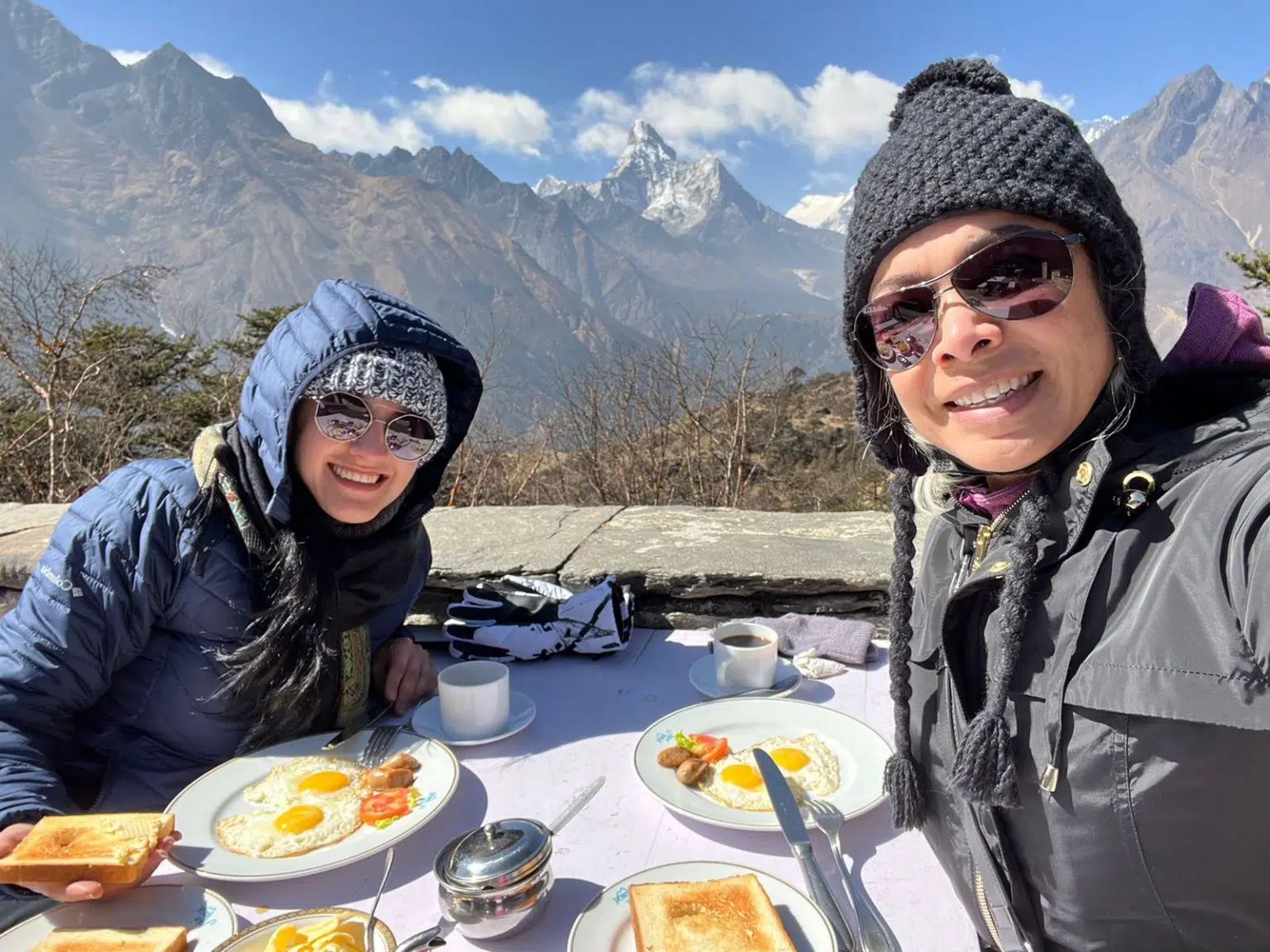
Ethical Considerations: Respecting Local Customs and the Environment
- Cultural Respect: Understanding and respecting the local Sherpa culture is crucial. This includes dressing modestly, being courteous while photographing people, and adhering to local customs, especially in religious sites.
- Environmental Consciousness: The fragile ecosystem of the Himalayas demands our utmost care. Avoid littering, use designated trails to prevent erosion, and respect wildlife habitats.
- Support Local Economy: Engage with and support local businesses. Hiring local guides and porters and purchasing from local vendors contributes positively to the community.
Sustainable Trekking Practices during Everest Base Camp Trek 2024
- Reduce Plastic Waste: Carry a reusable water bottle and use water purification methods instead of buying bottled water. This significantly reduces plastic waste in the region.
- Eco-Friendly Accommodations: Opt for sustainable teahouses and lodges using solar power or eco-friendly waste management systems.
- Leave No Trace: The ‘Leave No Trace’ principles should be a mantra for every trekker. Leave the places you visit as you found them or even cleaner.
- Energy Conservation: Be mindful of your energy use. Limit electricity use for charging devices, as energy in the region is often generated from limited resources.
- Minimize Campfire Impact: Avoid campfires as they contribute to deforestation. Use stoves for cooking and layer up for warmth.
The Impact of Tourism on the Himalayas Tourism, while a significant source of income for the local communities, can adversely impact the environment and local culture if not managed responsibly. Overcrowding, pollution, and cultural erosion are real challenges. By choosing ethical and sustainable practices, trekkers can help mitigate these impacts.
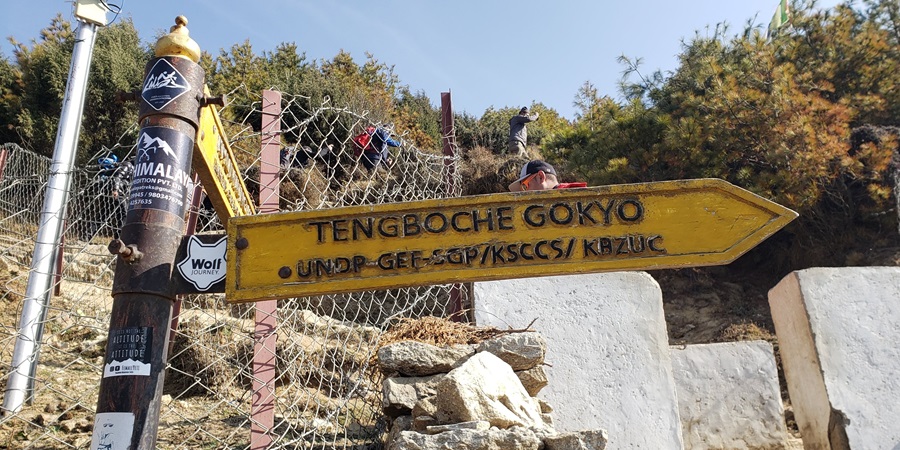
- Educate Yourself and Others: Be informed about the challenges faced by the region and share this knowledge with fellow trekkers.
- Choose Responsible Tour Operators: Opt for operators committed to sustainable and ethical trekking practices.
- Participate in Conservation Efforts: If possible, get involved in local conservation projects or contribute to organizations working to preserve the Himalayan environment.
Ethical and sustainable trekking on the Everest Base Camp Trek 2024 is a choice and a responsibility. By respecting local customs, embracing sustainable practices, and being mindful of our impact, we can preserve the Himalayas’ awe-inspiring beauty and rich cultural heritage for future trekkers to experience and cherish.
Integrating Local Nepali Words in Your Everest Base Camp Trek 2024 Experience
As you embark on the Everest Base Camp Trek in 2024, embracing the local Nepali language can significantly enrich your journey, offering a more authentic and immersive experience. Here’s a guide on incorporating 50 local Nepali words and phrases into your adventure:
- Greetings and Basic Communication
- Namaste: Begin every conversation with this respectful greeting.
- Dhanyabaad (Thank you) and Kripaya (Please) are essential in daily interactions.
- Ho (Yes) and Haina (No) will be frequently used.
- Food and Dining
- When enjoying local cuisine, know that Khana means food.
- Chiya (Tea) and Pani (Water) are staples on the Everest Base Camp Trek 2024.
- Try Daal Bhat (lentil soup and rice), Momo (dumplings), and Roti (flatbread).
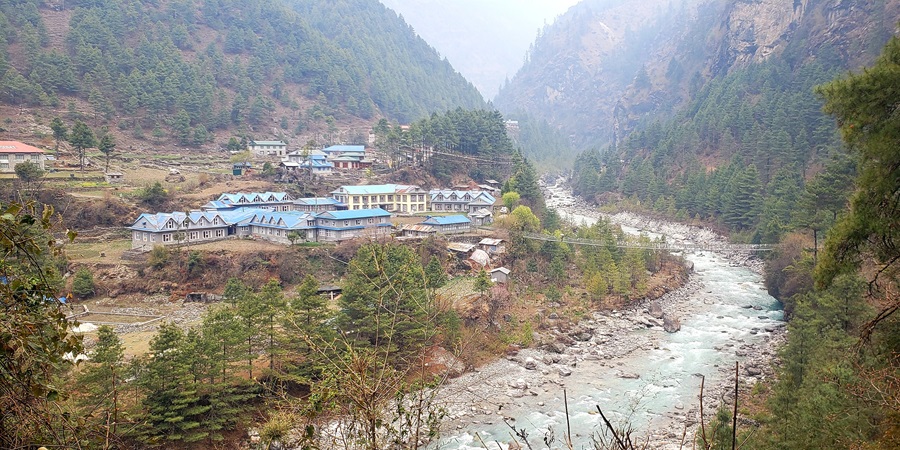
- Shopping and Transactions
- Ask Kati Ho. (How much?) when shopping at local Pasals (shops).
- Sastoma (Cheap) and Mahango (Expensive) can be helpful when bargaining.
- On the Trail
- Himal refers to the mountains you are trekking in.
- Bato means path or road, which is helpful when asking for directions.
- Bistarai (Slowly) is a helpful term to remember, especially on complex parts of the trek.
- Cultural Exchange
- Sathi (Friend) can be used to refer to fellow trekkers or locals you bond with.
- Shanti (Peace) reflects the serene environment you’re experiencing.
- Use Swagatam (Welcome) to express gratitude when locals host you.
- Safety and Well-being
- Aafnai (Own) could be used to refer to personal belongings.
- Thik Cha (It’s okay) to reassure others or yourself during challenging times.
- Chiso (Cold) and Garmi (Hot) describe the weather conditions you might face.
- Appreciating Wildlife and Nature
- Bagh (Tiger) and Sarpa (Snake) are some wildlife terms, though rare sightings.
- Biralo (Cat) and Kukur (Dog) might be encountered in villages.
- Respectful Terms for People
- Address elderly men as Baje and women as Budhi as a sign of respect.
- Adventure and Gear
- Talk about your Guide and Porter, which are integral to your trek.
- Jutta (Shoes) and Topi (Hat) are essential gear terms.
By integrating these Nepali words into your interactions, you demonstrate respect and an eagerness to immerse yourself in the local culture. Not only does this enhance your personal experience, but it also fosters a deeper connection with the community you’re visiting. Embrace these words as you navigate the breathtaking landscapes and rich cultural tapestry of the Everest Base Camp Trek 2024.
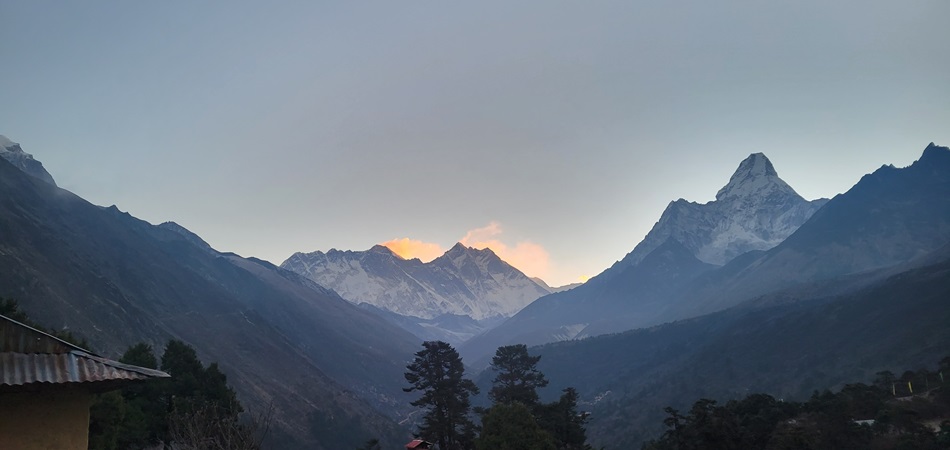
Conclusion: Embracing the Everest Base Camp Trek 2024 as a Journey of a Lifetime
As we reach the end of our comprehensive guide to the Everest Base Camp Trek 2024, it’s clear that this journey is much more than a physical challenge; it’s an expedition that promises to be both unforgettable and transformative. The trek to Everest Base Camp is demanding, testing your limits and pushing you out of your comfort zone. Yet, in these moments of challenge, the trek reveals its true beauty, offering rewards that go far beyond the stunning vistas.
The Everest Base Camp Trek 2024 journey stitches together breathtaking landscapes, vibrant cultures, and personal discovery. Every step on this trail brings you closer to understanding the Himalayas’ majesty and the human spirit’s resilience. The experiences you’ll gain, the people you’ll meet, and the memories you’ll create will leave an indelible mark on your life.
However, as we embrace this extraordinary adventure, let’s not forget our responsibility towards the environment and the local communities. Respecting the local culture, participating in sustainable trekking practices, and leaving a minimal environmental footprint are not just actions but commitments to preserving the natural and cultural heritage of this magnificent region. By trekking responsibly, we ensure that the Everest Base Camp Trek 2024 remains a source of wonder and inspiration for future generations.
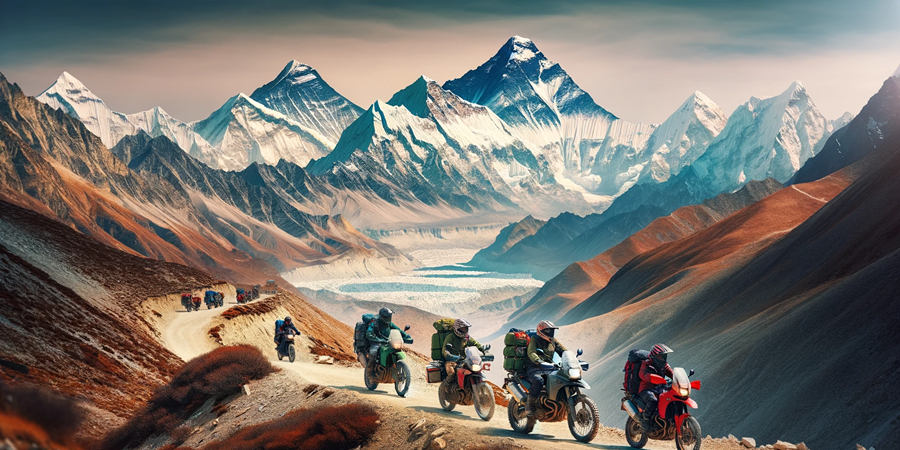
In 2024, as you set out on this remarkable trek, carry with you a sense of reverence for the natural world and a deep appreciation for the cultural richness of the Sherpa community. Let this trek be a journey where every step counts, not just towards your destination but in contributing to the sustainable and ethical exploration of one of the world’s most awe-inspiring landscapes.
The Everest Base Camp Trek 2024 awaits you, not just as a trail to be conquered but as a path to new perspectives, enduring friendships, and unforgettable experiences. May this trek be a journey that challenges you, changes you, and ultimately fulfils you in ways you never imagined.







